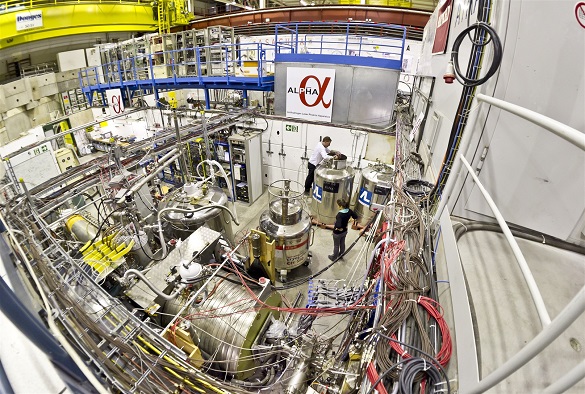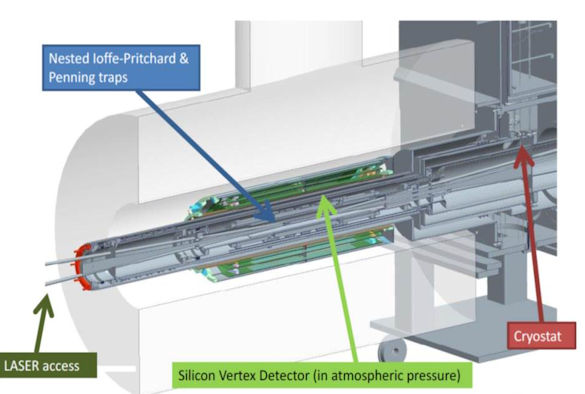ALPHA collaboration reports first measurements of certain quantum effects in antimatter
Published on

The ALPHA collaboration at CERN, which involves physicists from the University of Liverpool, has reported the first measurements of certain quantum effects in the energy structure of antihydrogen, the antimatter counterpart of hydrogen.
These quantum effects are known to exist in matter, and studying them could reveal as yet unobserved differences between the behaviour of matter and antimatter.
The results, described in a paper published in the journal Nature, show that these first measurements are consistent with theoretical predictions of the effects in “normal” hydrogen, and pave the way to more precise measurements of these and other fundamental quantities.
Jeffrey Hangst, spokesperson for the ALPHA experiment, said: “Finding any difference between these two forms of matter would shake the foundations of the Standard Model of particle physics, and these new measurements probe aspects of antimatter interaction – such as the Lamb shift – that we have long looked forward to addressing.
“Next on our list is chilling large samples of antihydrogen using state-of-the-art laser cooling techniques that rely on the current work. These techniques will transform antimatter studies and will allow unprecedentedly high-precision comparisons between matter and antimatter.”
Researchers from the University’s Department of Physics designed and fabricated one of the main tools in the ALPHA experiment, the silicon vertex detector, which is able to ‘see’ inside the ALPHA –apparatus.
Dr Petteri Pusa, who is leading Liverpool’s ALPHA operations at CERN, said: “In the heart of the experiment is a very sensitive Silicon Vertex Detector which enables us to see single antiatom interactions. These observations are the fundamental basis for the physics analysis in the experiment.”
Professor Carsten P Welsch, Head of the University of Liverpool’s Department of Physics, said: "These observations are an important step towards precision measurements of the fine structure and Lamb shift in the antihydrogen spectrum.
“Our Department has contributed the three-layer silicon vertex annihilation detector to the ALPHA experiment and this has allowed detecting the annihilation products with high efficiency and in turn the physics analysis. These results help test some of our most fundamental physics laws."
The ALPHA team creates antihydrogen atoms by binding antiprotons delivered by CERN’s Antiproton Decelerator with antielectrons, more commonly called “positrons”.
It then confines them in a magnetic trap in an ultra-high vacuum, which prevents them from coming into contact with matter and annihilating. Laser light is then shone onto the trapped atoms to measure their spectral response. This technique helps measure known quantum effects like the so-called fine structure and the Lamb shift, which correspond to tiny splittings in certain energy levels of the atom, and were measured in this study in the antihydrogen atom for the first time.
The team previously used this approach to measure other quantum effects in antihydrogen, the latest being a measurement of the Lyman-alpha transition.
The fine structure was measured in atomic hydrogen more than a century ago, and laid the foundation for the introduction of a fundamental constant of nature that describes the strength of the electromagnetic interaction between elementary charged particles. The Lamb shift was discovered in the same system about 70 years ago and was a key element in the development of quantum electrodynamics, the theory of how matter and light interact.
The Lamb-shift measurement, which won Willis Lamb the Nobel prize in physics in 1955, was reported in 1947 at the famous Shelter Island conference – the first important opportunity for leaders of the American physics community to gather after the war.
The paper `Investigation of the fine structure of antihydrogen’ is published in Nature.
[caption id="attachment_75379" align="alignnone" width="585"] Cut-through of ALPHA’s neutral atom trap. The Liverpool build Silicon Vertex Detector surrounds the central experiment, where the antihydrogen atoms are produced and stored, and monitors the antiatom annihilations[/caption]
Cut-through of ALPHA’s neutral atom trap. The Liverpool build Silicon Vertex Detector surrounds the central experiment, where the antihydrogen atoms are produced and stored, and monitors the antiatom annihilations[/caption]
Technical Note:
Both the fine structure and the Lamb shift are small splittings in certain energy levels of an atom. The fine-structure splitting of the second energy level of hydrogen is a separation between the so-called 2P3/2 and 2P1/2 levels in the absence of a magnetic field. The splitting is caused by the interaction between the velocity of the atom’s electron and its intrinsic (quantum) rotation. The “classic” Lamb shift is the splitting between the 2S1/2 and 2P1/2 levels also in the absence of a magnetic field. It is the result of the effect on the electron of quantum fluctuations associated with virtual photons popping in and out of existence in a vacuum.
In their new study, the ALPHA team determined the fine-structure splitting and the Lamb shift by inducing and studying transitions between the lowest-energy level of antihydrogen to the 2P3/2 and 2P1/2 levels in the presence of a magnetic field of 1 Tesla. Using the value of the frequency of a transition that they had previously measured, the 1S–2S transition, and assuming that certain quantum interactions were valid for antihydrogen, the researchers inferred from their results the values of the fine-structure splitting and the Lamb shift. They found that the inferred values are consistent with theoretical predictions of the splittings in “normal” hydrogen, within the experimental uncertainty of 2% for the fine-structure splitting and of 11% for the Lamb shift.